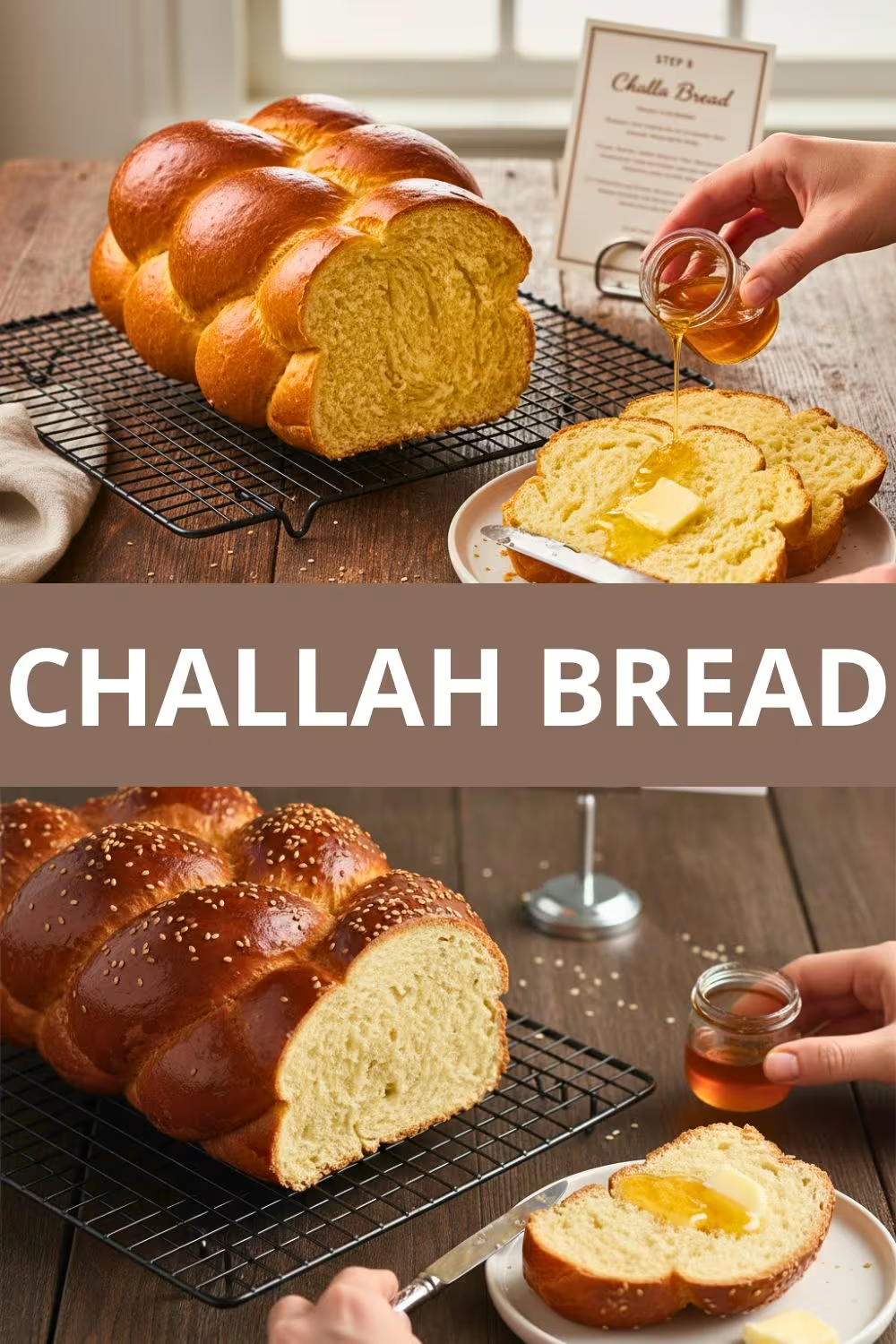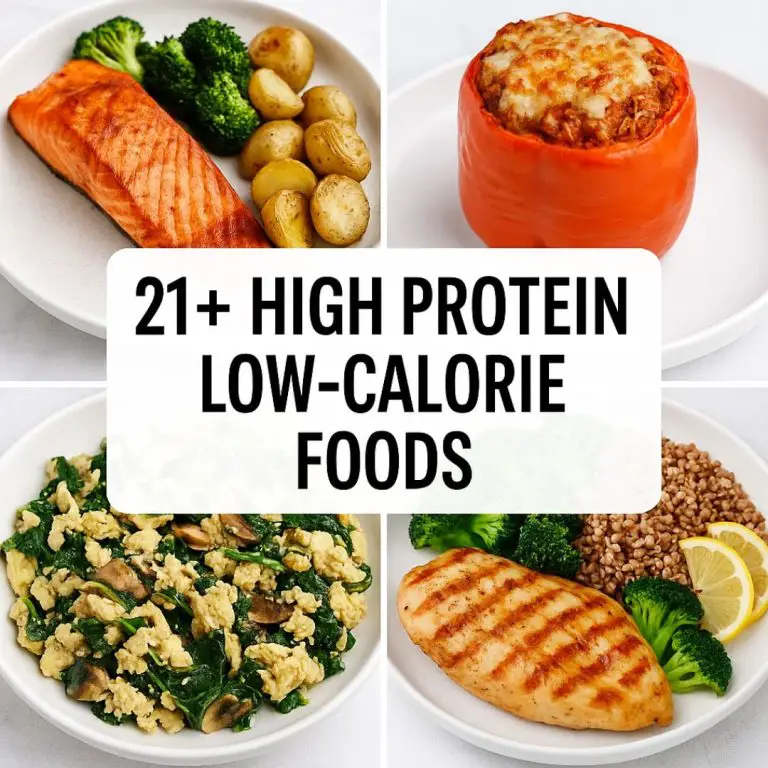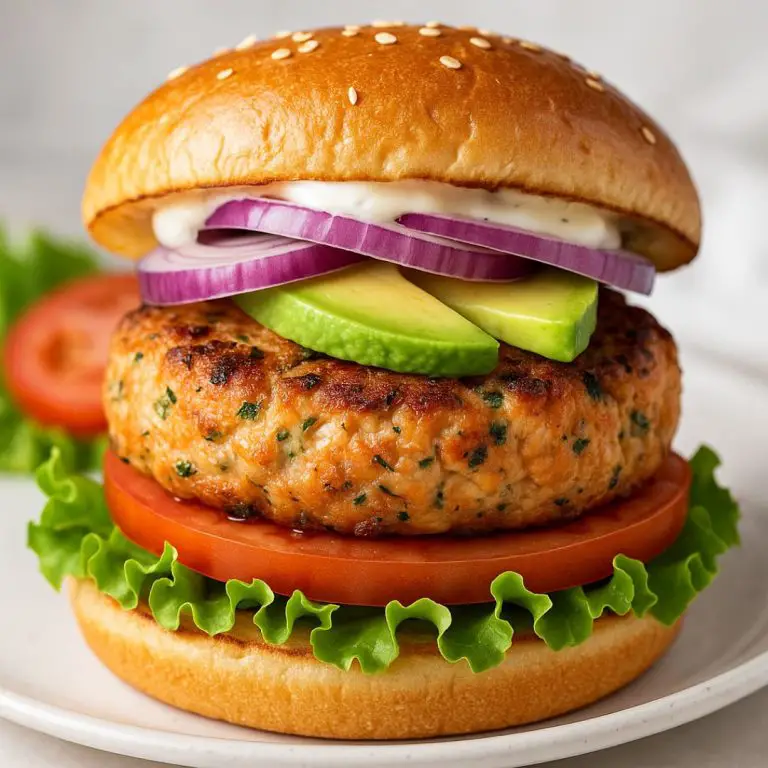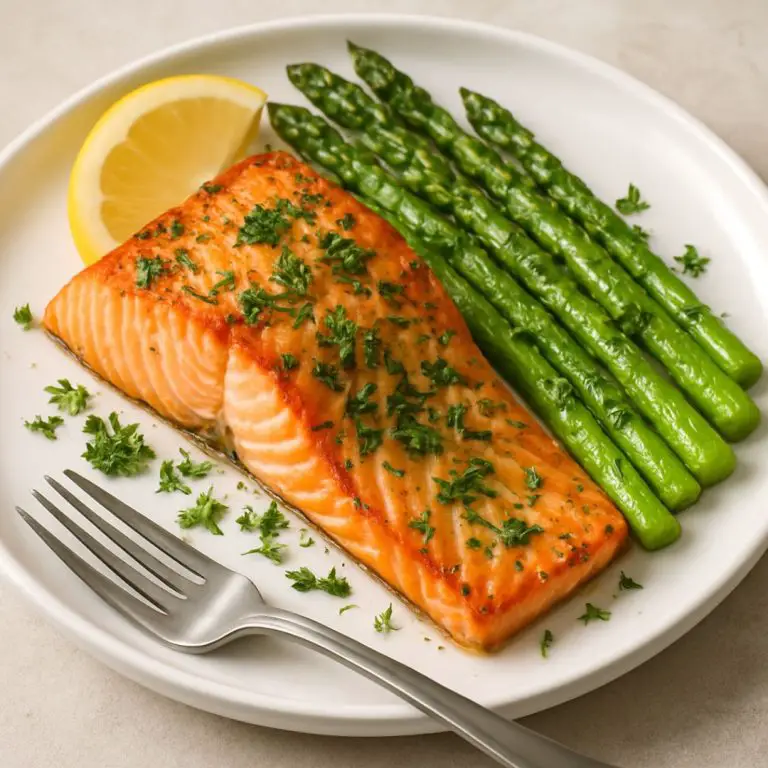🥖 Homemade Challah Bread Recipe | Traditional Jewish Braided Bread for Shabbat & Holidays
Soft, fluffy, golden-brown challah bread made easy at home – perfect for Shabbat, Rosh Hashanah, or holiday feasts.
For those of you who have tried challah bread before, this is nothing new, but if you have ever tried making it at home, you have probably searched for the best Challah bread recipe online. And you have probably seen dozens of options, but this one is the perfect combination of tradition, taste, and ease. Challah, the iconic Jewish braided bread, is a soft, slightly sweet, golden loaf traditionally served on Shabbat, Rosh Hashanah, Hanukkah, and other Jewish holidays. Unlike brioche (which uses butter and milk), challah is made with oil and eggs, making it light, fluffy, dairy-free, and perfect for anyone who wants an authentic homemade artisan bread.
This easy Challah bread recipe is designed for both beginners and experienced bakers. It walks you through every step—from activating yeast and kneading dough to braiding like a pro—so you can create a bakery-quality loaf right in your own kitchen. Beyond its beauty, challah is a versatile bread. Serve it with butter, honey, or jam for breakfast, pair it with soups and roasts for dinner, or transform leftovers into French toast, bread pudding, or gourmet sandwiches. That’s why it ranks among the most searched holiday bread recipes and is often called the best bread for French toast.
When you bake this bread, you’re not just making food—you’re carrying on a centuries-old tradition of Jewish baking. And the best part? You don’t need any fancy equipment, just a few pantry staples and some love for bread-making. So let’s dive into this step-by-step challah recipe that will make your kitchen smell heavenly, your table look festive, and your family (or guests) ask for seconds.
Suggested: Shrimp & Grits Recipes
🍞 Homemade Challah Bread Recipe (Traditional Jewish Braided Bread)
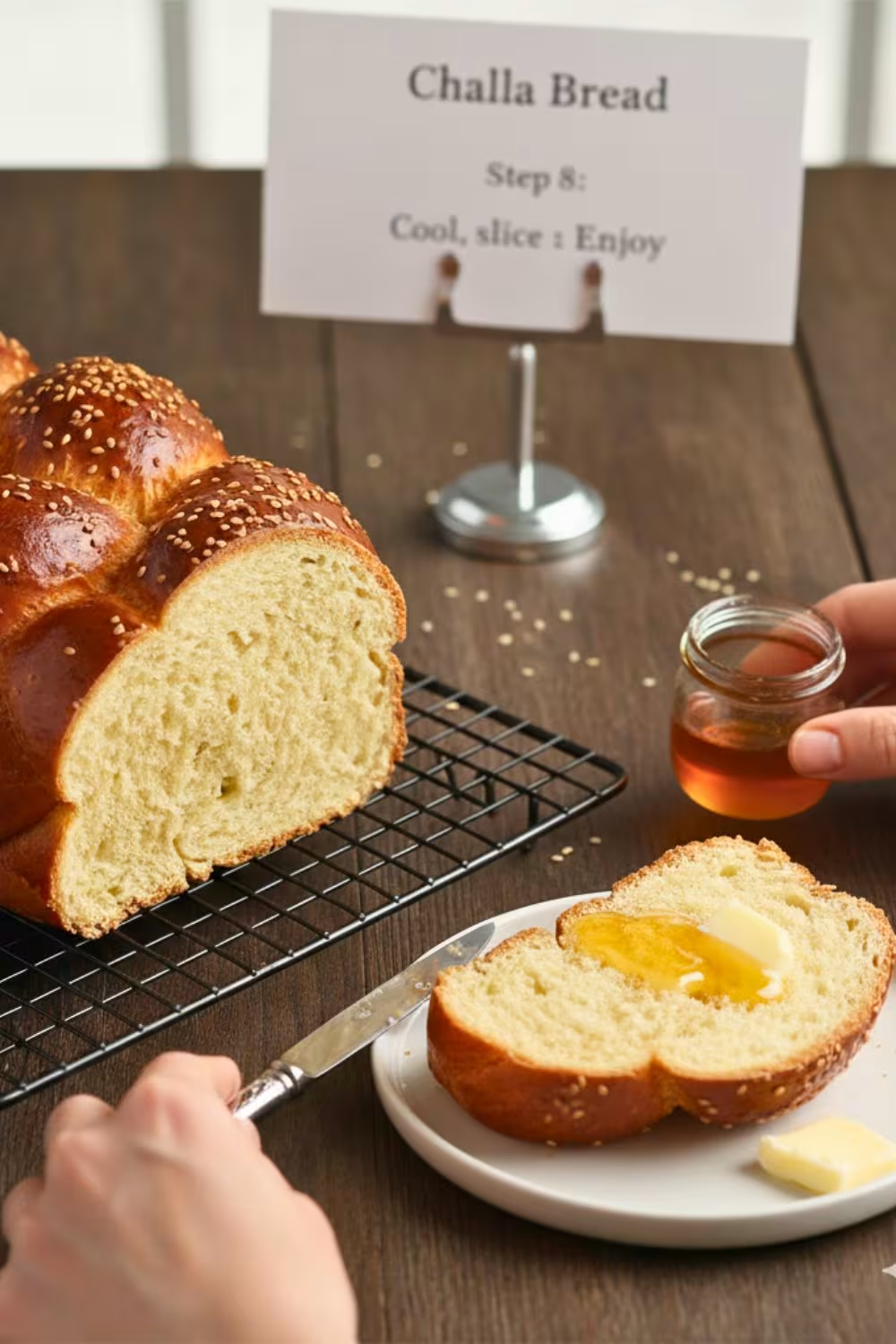
This traditional Challah Bread recipe is a soft, fluffy, slightly sweet braided bread that’s perfect for Jewish holidays (Shabbat, Rosh Hashanah, Hanukkah, Passover meals) or any festive dinner table. With a golden crust and tender inside, this homemade artisan bread is ideal for pairing with butter, honey, or savory dips, and also makes the best French toast the next morning.
Ingredients
- 4 cups all-purpose flour (plus more for kneading)
- 2 ¼ tsp active dry yeast (1 packet)
- ½ cup warm water (110°F / 43°C)
- ⅓ cup sugar or honey (natural sweetener option)
- 2 large eggs (plus 1 egg for egg wash)
- ¼ cup vegetable oil or olive oil
- 1 tsp salt
- Optional toppings: sesame seeds, poppy seeds, or everything bagel seasoning
Instructions
Activate the Yeast
- In a bowl, dissolve yeast in warm water with 1 tsp sugar. Let sit for 5–10 minutes until foamy.
Mix the Dough
- In a large mixing bowl, whisk eggs, oil, sugar (or honey), and salt. Add the yeast mixture.
- Gradually add flour until a soft dough forms.
Knead the Dough
- Transfer to a floured surface and knead for 8–10 minutes until smooth and elastic.
- Place in a greased bowl, cover with a damp cloth, and let rise for 1–2 hours, or until doubled in size.
Shape & Braid
- Punch down the dough. Divide into 3 equal portions. Roll into long ropes and braid tightly. Pinch ends to seal.
Second Rise
- Place braided dough on a baking sheet lined with parchment paper. Cover and let rise for 30–45 minutes.
Egg Wash & Bake
- Brush with beaten egg wash for a golden crust.
- Optionally sprinkle with sesame or poppy seeds.
- Bake at 350°F (175°C) for 30–35 minutes until golden brown.
Cool & Serve
- Let rest 15 minutes before slicing. Serve warm with butter, jam, or honey.
Notes
- Use bread flour for extra chewiness and bakery-style texture.
- For a sweeter holiday challah, add raisins or chocolate chips.
- To store, wrap in foil or an airtight container – stays fresh for 3 days at room temp.
- Freeze for up to 2 months – reheat in the oven for fresh-baked taste.
- Makes amazing French toast, bread pudding, or grilled cheese sandwiches.
Serving Suggestions
- Perfect for Shabbat dinner, Rosh Hashanah, and Hanukkah feasts.
- Slice and serve with butter, cream cheese, honey, or jam.
- Pair with savory dishes like roast chicken, soups, or Mediterranean dips.
- Use leftover challah for French toast, sandwiches, or stuffing recipes.
Nutrition Information:
Yield:
12Serving Size:
1Amount Per Serving: Calories: 258Total Fat: 8gSaturated Fat: 1gTrans Fat: 0gUnsaturated Fat: 6gCholesterol: 31mgSodium: 224mgCarbohydrates: 40gFiber: 2gSugar: 7gProtein: 6g
Related: Banana Bread Recipe
🥖 Ingredients You’ll Need — Challah Bread (Shopping + Substitutes)
Here is are ingredient list for this classic Challah bread recipe, which is perfect for shoppers and bakers. Each item includes quick substitution advice so you can choose the best artisan bread ingredients, budget-friendly alternatives, or high-protein / healthier swaps.
-
4 cups (480g) all-purpose flour
Or 3½ cups AP + ½ cup bread flour for extra chewiness — bread flour gives a bakery-style texture. -
2 ¼ tsp (1 packet) active dry yeast
Instant yeast works too — reduce the warm water time. Use fresh yeast for reliable rise. -
½ cup (120ml) warm water (about 110°F / 43°C)
Test temperature with your wrist — not too hot to kill yeast. -
⅓ cup (113g) sugar or honey
-
2 large eggs + 1 egg for egg wash
Eggs add shine & structure. Vegan option: use 2 tbsp flaxseed + 6 tbsp water (per egg). -
¼ cup (60ml) vegetable oil or light olive oil
-
1 tsp fine sea salt
Adjust to taste — do not skip; salt controls fermentation and flavor. -
Optional toppings: sesame seeds, poppy seeds, everything seasoning
Brush with egg wash before sprinkling for best adhesion and glossy finish.
- Want bakery texture: Use part bread flour (higher protein).
- Need dairy-free / kosher: Use oil (not butter) and check egg usage for dietary rules.
- Vegan: Use flax eggs + plant-based milk and oil.
- Low-sugar: Reduce sugar to ¼ cup and add 1 tbsp honey for flavor.
Related: Low-Carb Breakfast Burrito Recipes
How to Make Challah Bread — Step-by-Step (Easy, Soft & Braided)
Step 1 — Activate the yeast (Make sure the yeast is lively)
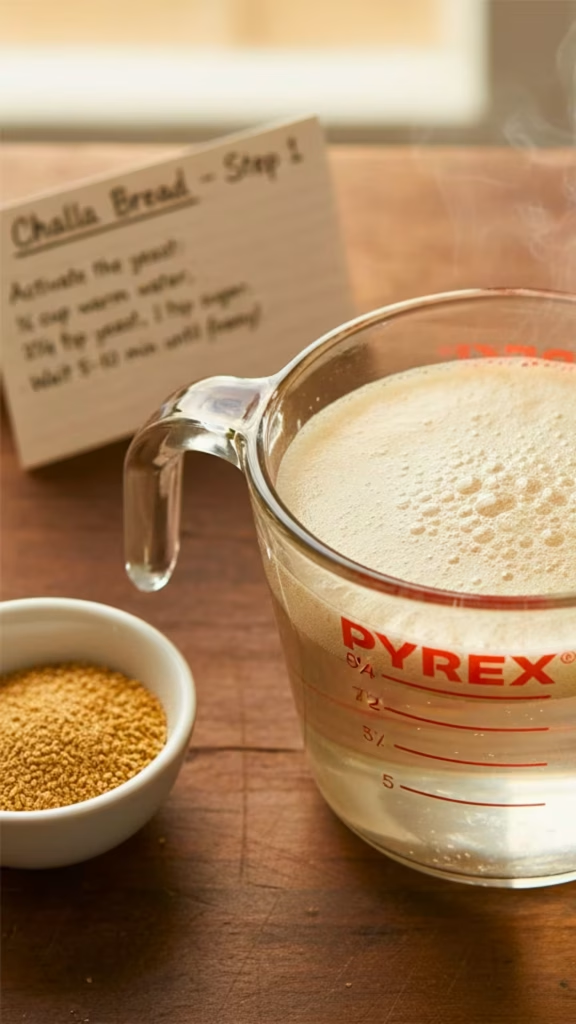
Start by dissolving 2¼ tsp active dry yeast in ½ cup warm water (≈110°F / 43°C) with 1 tsp sugar. Wait 5–10 minutes until it’s foamy and fragrant — that foamy cap means your yeast is awake and ready. This simple yeast check prevents flat, dense loaves and is crucial for any reliable yeast bread recipe.
Pro tip: If the yeast doesn’t foam in 10 minutes, the yeast may be expired — swap it out to avoid a failed rise.
Step 2 — Mix the dough (Eggs + oil + honey for soft crumb)
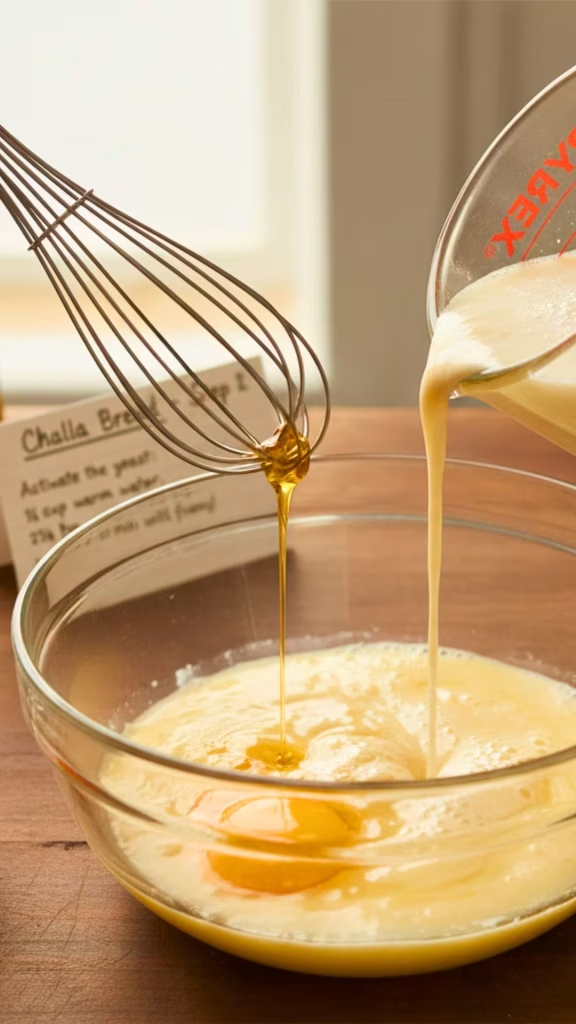
In a large bowl, whisk 2 large eggs, ¼ cup oil (vegetable or mild olive oil), ⅓ cup sugar or honey, and 1 tsp salt. Add the foamy yeast mixture and stir. Gradually add 4 cups flour until a cohesive, slightly tacky dough forms. This balance of oil + egg is what makes challah an ideal braided bread for a soft, airline-loft crumb.
Step 3 — Knead until smooth & elastic (Hand or stand mixer)
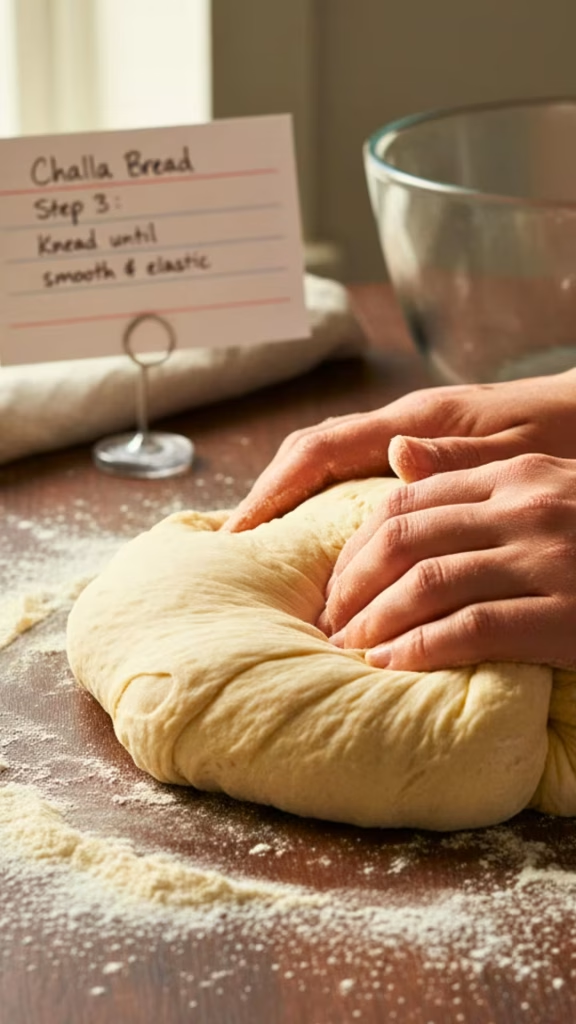
Knead on a lightly floured surface 8–10 minutes by hand, or 6–8 minutes with a stand mixer + dough hook. You want a dough that’s soft, slightly tacky, and springs back when poked. This step builds gluten — the backbone of a great crumb in any artisan bread recipe.
If the dough is too sticky, add flour a tablespoon at a time. If it’s too dry, add water a teaspoon at a time. Aim for that perfect elasticity — it’s what yields a soft, airy challah.
Step 4 — First rise: double in a warm spot (flavor & texture)
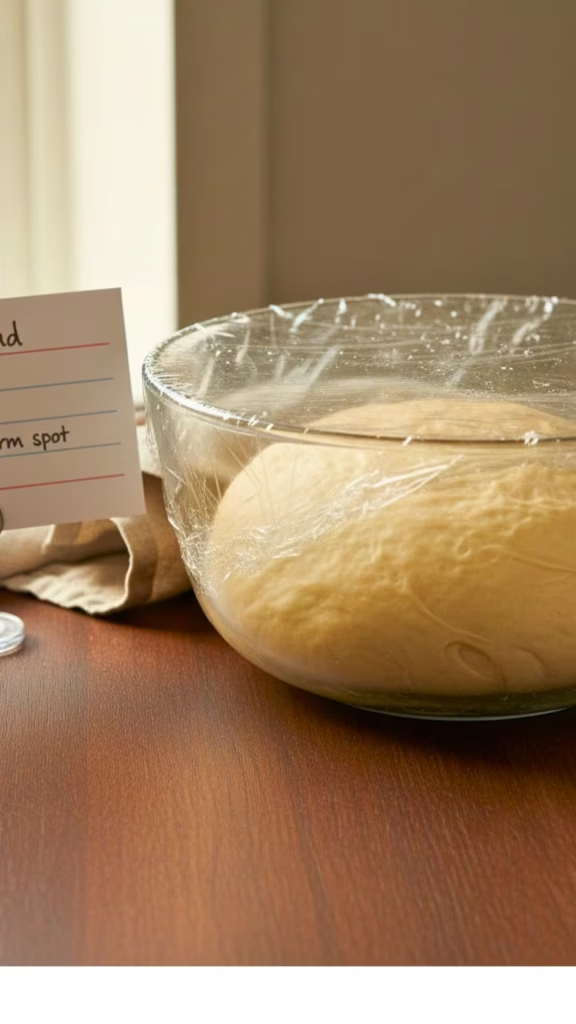
Grease a large bowl, place the dough inside, cover with a damp towel or plastic wrap, and let rise 1–2 hours at room temperature until doubled. For more depth of flavor, cover and refrigerate overnight — a slow cold ferment improves taste and keeps the loaf fresher longer.
Step 5 — Shape & braid (3-strand or go pro with 6-strand)
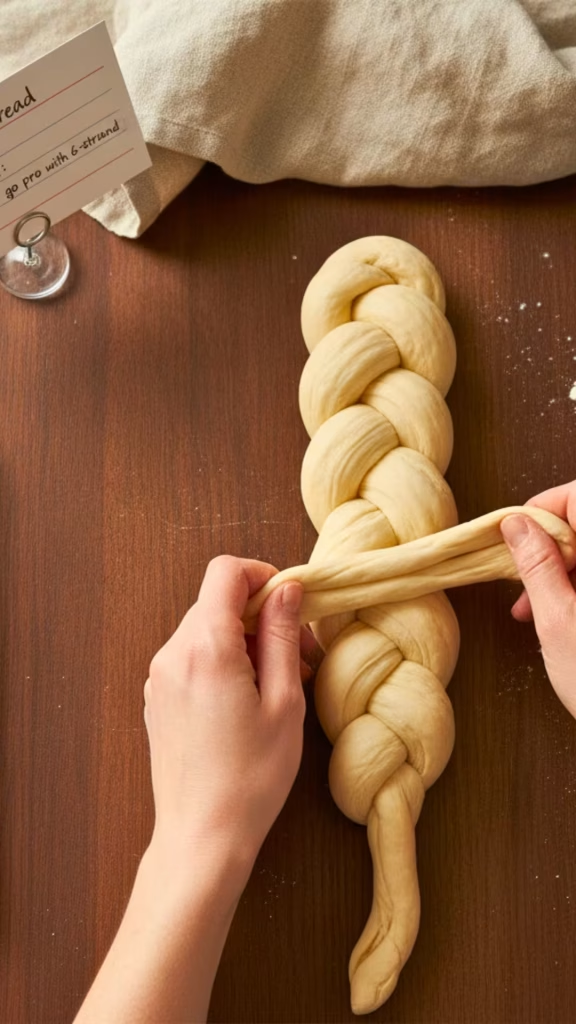
Gently deflate the dough and divide into 3 or 6 equal pieces. Roll each into a long rope (about 14–16 inches). Braid tightly but gently, tucking the ends under to seal. A tight braid yields even slices and the classic pull-apart crumb. Want a showstopper? Try a 6-strand braid or a round challah for Rosh Hashanah.
Step 6 — Second rise (Puff, don’t overproof)
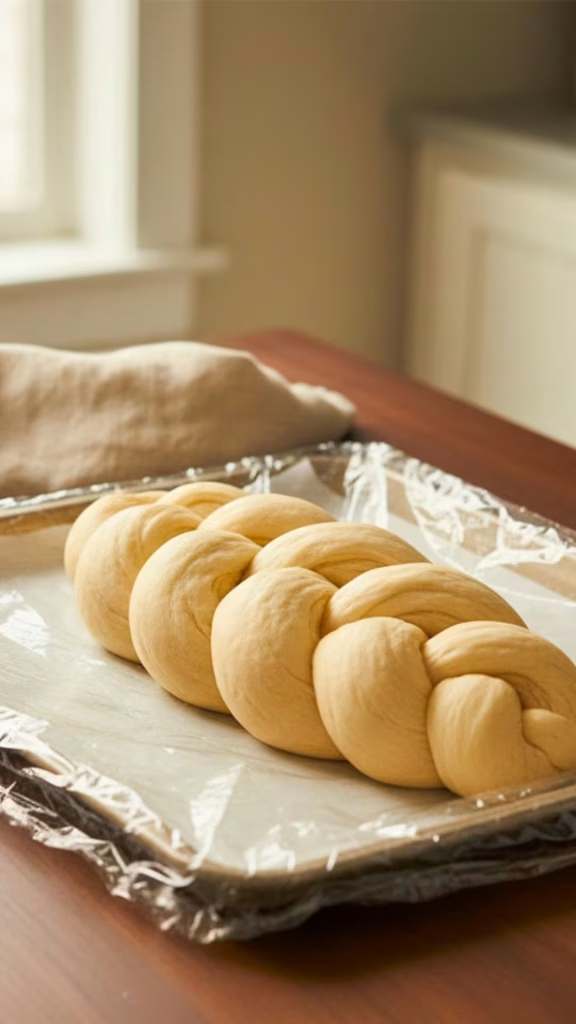
Place the braided loaf on a parchment-lined baking sheet, cover loosely, and let rise 30–45 minutes until puffy. Don’t let it overproof — you want puffiness but not collapse. This is the final chance for the loaf to develop lift before it meets heat in the oven.
Step 7 — Egg wash & bake (Shiny crust, golden color)
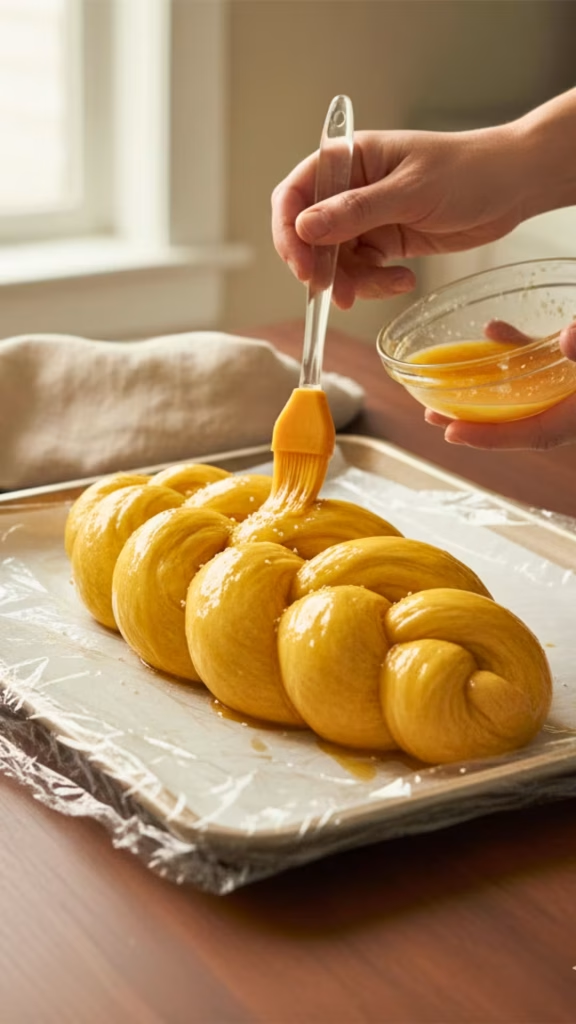
Preheat oven to 350°F (175°C). Brush the loaf with a beaten egg (or egg + 1 tsp water for a more even gloss). Sprinkle with sesame or poppy seeds if desired. Bake 30–35 minutes until deep golden and internal temperature reads ~190°F (88°C). Rotate the pan after 20 minutes if your oven has hot spots.
Tip: If the crust browns too quickly, tent loosely with foil for the last 10 minutes to finish cooking without burning the exterior.
Step 8 — Cool, slice & enjoy (Best for French toast too)
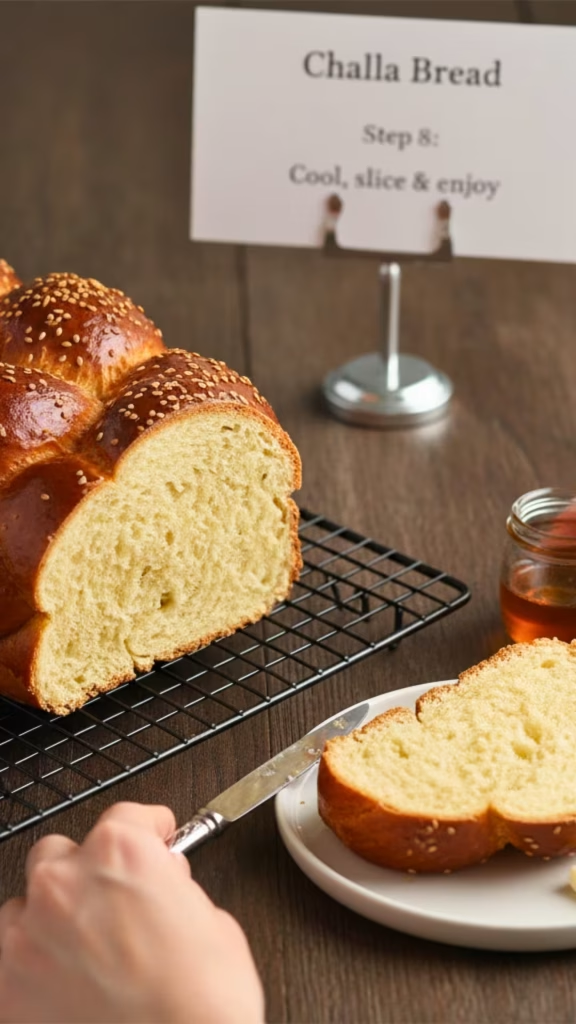
Move the loaf to a rack and cool 15–30 minutes. Resist slicing while it’s piping hot — chilling slightly gives cleaner slices and sets the crumb. Serve warm with butter or honey, or save leftovers for the best French toast.
Related: High Protein Smoothie Recipes
🍽️ Serving Suggestions — What to Eat with Homemade Challah
Challah is ridiculously versatile — soft, slightly sweet, and perfect for both sweet and savory dishes. Below are tried-and-true serving ideas that make your homemade challah bread the star of breakfast, brunch, dinner, and leftovers.
☀️ Breakfast & Brunch — French Toast & Toasted Slices
For an awesome morning, slice challah thick (1–1.5″), soak in a rich egg-cream mixture and pan-fry for the best French toast ever. Top with maple syrup, whipped mascarpone, or fresh berries.
🎉 Holiday Dinner — Shabbat, Rosh Hashanah & Festive Meals
Serve a braided challah warm alongside roast chicken, brisket, or a hearty soup. A round challah is traditional for Rosh Hashanah — symbolize continuity and sweetness.
🥪 Sandwiches & Savory — The Best Bread for Sandwiches
Use challah for deli sandwiches, grilled cheese, or a luxe BLT. Its soft crumb holds fillings without being gummy. Toast slices for sturdier sandwiches.
Tip: toast and spread with garlic butter for an instant upgrade.
♻️ Leftovers & Make-Ahead — Freeze, Reheat, Repurpose
Stale challah is a treasure — bread pudding, strata, croutons, or French toast sticks. Wrap well and freeze up to 2 months.
Tip: Refresh frozen slices in a 350°F oven for 8–10 minutes for bakery-fresh texture.
🍯 Sweet Ideas — Dessert & Breakfast Upgrades
Turn challah into a dessert: stuffed challah with cinnamon sugar, Nutella, or sweet cheese.
🍷 Pairings — What to Serve with Challah
Classic pairings: salted butter, local honey, labneh, smoked fish, or tangy pickles.
Drinks: strong coffee, herbal tea, or a light red wine.
Related: Keto Overnight Oats Recipes
Recipe Variations — Make Your Perfect Challah
Different challah variations for every cook: vegan challah, whole wheat challah, stuffed & sweet versions, round challah for Rosh Hashanah, and quick mini rolls. Choose the variation that fits your diet, occasion, and baking confidence.
Vegan Challah — Egg-Free Braided Bread
Replace whole eggs with aquafaba (3 tbsp per egg) or flax eggs (1 tbsp flaxseed meal + 3 tbsp water, let sit). Use plant-based milk and a tablespoon of maple syrup to balance sweetness. Knead until the dough is elastic — vegan dough benefits from extra kneading for structure.
Choose this variation if you want a dairy-free, egg-free challah that still braids beautifully and makes excellent French toast.
Use Vegan MethodWhole Wheat Challah — Nutty & Hearty
Replace up to 50% of the all-purpose flour with whole wheat flour. Increase hydration by 1–2 tbsp of water or milk for every cup of whole wheat. Let the dough rest 10 minutes after mixing (autolyse) so the flour hydrates — this prevents dense loaves.
Bake Whole GrainStuffed Challah — Dessert or Savory Surprise
Roll each rope flat, add a thin layer of filling, then fold and braid. For sweet fillings, dust with powdered sugar after cooling. For savory, brush with olive oil and sprinkle flaky salt before baking.
Try a Stuffed VersionRound Challah — Symbolic Rosh Hashanah Loaf
Form 3 (or 6) ropes and coil them into a round wreath, or braid into a circular shape. Brush with egg wash and top with honey glaze for sweetness. You’ll live this Rosh Hashanah Bread Recipe.
Make a Round LoafSweet Raisin or Cinnamon Challah — For Breakfast & Brunch
Fold in 1 cup of raisins or dried fruit during the last stretch of kneading. For cinnamon swirl, roll ropes thin, spread cinnamon-sugar, then roll and braid. Bake slightly longer at lower heat (325°F/165°C) if loaf is dense with fruit.
Make Sweet ChallahMini Challah Rolls — Perfect for Dinner Parties
Divide dough into 12–18 balls, roll into small ropes or knots, then let rise 20–30 minutes. Brush with egg wash, sprinkle sesame seeds, bake 12–16 minutes until golden.
Bake Mini RollsFrequently Asked Questions — Challah Bread Recipe
How do I make challah bread step-by-step (easy yeast bread recipe)? ▾
What makes challah different from brioche and other egg breads? ▸
Can I make challah without eggs (vegan challah recipe)? ▸
How long should challah dough rise and can I refrigerate it overnight? ▸
Why won’t my challah get a shiny, golden crust (how to get bakery shine)? ▸
Can I freeze challah and how do I reheat it so it tastes fresh? ▸
What are the best flours and substitutions for challah (whole wheat, bread flour)? ▸
How do I braid challah — 3-strand, 4-strand, or 6-strand tips? ▸
Is challah suitable for holidays like Rosh Hashanah and what’s a round challah? ▸
What are smart serving ideas — best bread for French toast or sandwiches? ▸
If you like this article about the Homemade Challah Bread Recipes, please share it with your friends on Facebook and Pinterest. Also, subscribe to my blog to get all the latest content first on your mobile.

